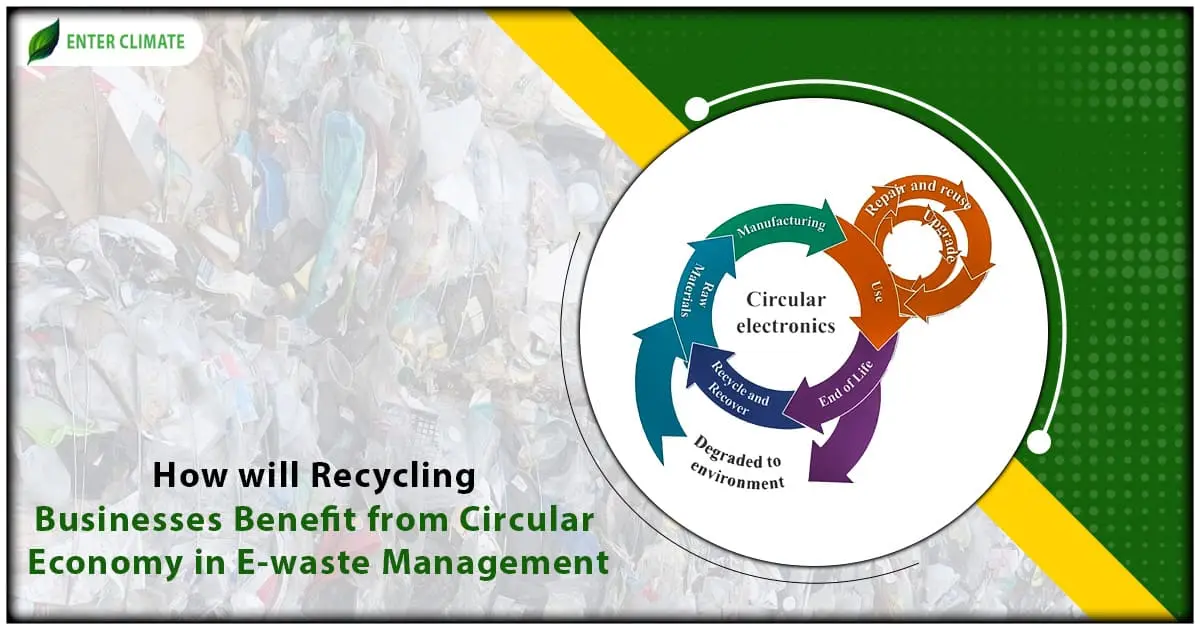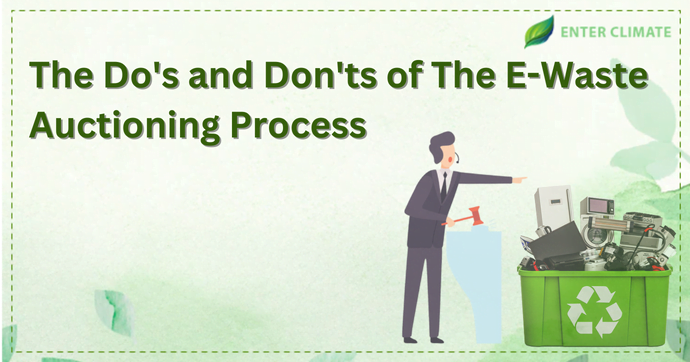How will Recycling Businesses Benefit from Circular Economy in E-waste Management?
 21 Jul, 2023
21 Jul, 2023 
Although many countries started adopting Circular Economy in E-waste Management way earlier, in India for a long time, the electronics and electrical equipment manufacturing sector kept functioning on a linear model. This led to the e-waste management sector remaining disconnected from the manufacturing. The product-related externalities were not internalised due to the easier take-make-dispose model. Earlier, E-Waste[1] recycling was being performed with crude collection methods, recycling and disposal and the recycled resources were not used. Today we are seeing a growing volume of e-waste, which is still being recycled through unscientific recycling methods in the informal sector, that frequently deploy polluting techniques for dismantling and metal recovery and that too with far lesser efficiency. This also led to severe health hazards amongst workers and hazardous waste being dumped in landfills.
Amidst all these environmental concerns, India remained dependent on other countries for imports of many crucial metals due to their limited availability for a long time. Dangerous e-waste dismantling, metal recovery, and disposal techniques were deteriorating our land and water resources. On the other hand, our linear approach to production meant indiscriminate production and energy-intensive extraction of metals that were later lost as waste.
The government soon took cognizance of the former issue by coming up with the E-Waste (Management and Handling) Rules in 2011, the E-Waste (Management) Rules of 2016 and the concept of Extended Producer Responsibility (EPR). Subsequently, the Central Pollution Control Board periodically updated the SOP for recycling activities, and post-compliance also became strict. Comes in 2022, and we see the E-Waste Management Rules of 2022 that tries to address the other issue. Today we can see the government’s impetus to promoting a circular economy in e-waste management. In this article, we will understand how the past developments assisted the E-Waste Recycling Sector and how they will benefit from Circular Economy, the new approach the government is trying to include.
Realising the need of Circular Economy in E-waste Management
Today e-waste management is the most lucrative and profitable waste management segment in India. The present E-Waste Management Rules,2022, which came into force on 1st April 2023, lists certain legal obligations for the manufacturer, producer, Refurbisher, dismantler, and recycler of e-waste.
Growth of E-waste Collection Infrastructure
The government has released guidelines for takeback/ buyback systems for old/end-of-life EEE and made it mandatory for manufacturers under the 2016 rules. The leakage of this waste to landfills is being gradually plugged with the rules identifying the role of waste collection. Hazardous e-waste that earlier ended the informal sector has started getting channelised into the formal sector, thereby reducing the loss of precious metals and the pollution that was caused due to unscientific collection and storage of e-waste.
Today, those manufacturers who have invested in the collection infrastructure have access to valuable resources that they can use from their e-waste, all thanks to India’s EPR regime. This has given them a competitive edge over their competitors by analysing different consumer and product specifics More people now have access to trusted e-waste collection where they can safely dispose their gadgets without the fear of misuse. Consumers can now exchange their old gadgets and get decent value for products reaching their end of life- all within the comfort of their homes and offices. The manufacturers can accurately calculate the Advanced Recycling Fee (ARF) with such data, which can then be shared by waste generators and producers.
Role of Authorised Dismantlers
As the majority of e-waste businesses perform dismantling operations, their role in e-waste management cannot be ignored. After dismantling, the usable components are reduced in size, which leads to easier storage and transportation. However, improper dismantling and the subsequent disposal of discarded e-waste as solid waste has severe impacts on human health and the environment since the waste contains hazardous constituent as well as heavy metals.
Most e-waste businesses perform dismantling operations due to the limited labour, machinery and investment requirement. However, improper dismantling and the subsequent disposal of discarded e-waste have severely impacted the worker’s health and environment since the waste contains hazardous constituent heavy metals. The advantages associated with dismantling has led to a vast network of unregistered dismantlers and recyclers in the country.
That is why the governmental agencies gave greater impetus on dismantling when bringing the unorganised sector into the chain of resource recovery. For a country like India, eco-friendly collection, dismantling is crucial in preventing the leakage of waste into the informal sector. Registered dismantlers are being employed by manufacturers to perform dismantling for component recovery and sometimes for metal recovery from e-waste. Proactive steps by stakeholders coming together under the Circular Economy in E-waste Management and as establishing authorised collection centres, takebacks and buyback schemes, and skill enhancement of the workers will prevent pollution emanating from their improper dismantling.
Role of Metal Recycling Businesses
The value of precious metals being lost along with e-waste is approximately 57 billion USD annually. The e-waste is considered a reservoir of precious and base metals such as silver, gold, palladium, iron, copper etc. These precious metals can serve as a secondary resource for recovery at low operating costs.
Apart from the value and rareness of these metals, the fact that India imports many of the metals has also helped in the growth of precious metal recycling businesses, providing OEM manufacturers with a cheaper and eco-friendly path to source these metals in manufacturing crucial components like PCB, batteries, computing processors etc.
As a result, manufacturers are also increasingly moving towards adopting circular economy in e-waste management to help them access cheaper resources from the untapped recycling sector, lower their operation’s environmental impact, and address critical e-waste challenges.
Role of TSDFs
Treatment, Storage and Disposal Facilities (TSDF) play a vital role in e-waste management and the utilisation of non-recyclable e-waste generated by e-waste businesses performing the collection, dismantling, refurbishing, as well as the OEMs. TSDF specialise in transporting and storing hazardous components of the e-waste away from a generator’s site as per the SOPs released for specific types of waste.
As EEE manufacturing is dependent on high material consumption with metals like iron, copper, silver, gold, aluminium, manganese, chromium and zinc, along with various rare earth elements, recycling is a very lucrative concept in promoting circular economy in e-waste management.
Future of E-Waste Management Businesses under the Circular Economy
To move in the direction of the circular manufacturing model, the manufacturers and traders needed a formalised collection network that the consumers could use. The present approach of the government shows a clear intention of promoting a circular approach among all key stakeholders- the manufacturers, consumers and the recycling sector.
For Manufacturers
The circular approach aims to replace the end-of-life concept of E-Waste with its restoration and regeneration while encouraging manufacturers to shift towards the usage of the superior design of materials, products, systems, and business models and effective waste elimination. Circular Economy in E-Waste management will nurture competitiveness among the OEMs as they know that their long-term survival will depend on sustainable and eco-friendly practices, and the successful implementation of eco-efficiency will contribute to their success.
For Consumers
The circular approach will encourage consumers to choose those products with recycled components which will in turn encourage the other stakeholders to utilise such resources by keeping them usable with consumer for as long as possible. This will help minimise wastage at each stage of the product’s recycled life-cycle and stakeholders will be able to extract the maximum value through recovering, reusing, repairing, remanufacturing, and regenerating products.
For Waste Management Sector
The e-waste recyclingsector is also encouraged to devise mechanisms for efficient collection and recycling and work towards integrating circularity to ensure recovery and trading of secondary raw materials with registered entities and ensure quality for repair and refurbished products. Another benefit of Circular Economy in E-waste Management has been the access to refurbished products through e-commerce websites.
The recently introduced Green Credit Scheme, a key component in the Mission LiFE initiative of the Government of India, will also help boost the circular approach in the economy of manufacturing and will, in turn, also benefit the e-waste recycling businesses.
Conclusion
A sustainable and circular approach towards manufacturing would not only lead to reduced waste generation and pollution associated with disposal but also promote circular economy in e-waste management that will save related costs for the manufacturers. Transitioning to CE will reduce dependency on virgin materials and enhance resource productivity. Reusability of resource use can also contribute towards reducing GHG emissions and help meet climate change commitments. But this should not be seen as a challenge but another opportunity for new entrepreneurs that can develop an easily accessible and mature collection, dismantling, or disposal network for the areas untouched by waste management businesses. Their contribution will be crucial for developing a robust core of India’s e-waste ecosystem.
FAQs
A circular economy approach in the management of e-waste will play an important role in resource efficiency, reduction in pollution and waste, longer product life, recovery of precious and rare materials, minimisation of occupational and health hazards as well as in giving an impetus to the evolution of recycling industry in India.
Circular Economy in E-Waste management will nurture competitiveness among the OEMs as they know that their long-term survival will depend on sustainable and eco-friendly practices, and the successful implementation of eco-efficiency will contribute to their success.
E-Waste management in many states of India still requires shifting from existing crude collection and recycling methods, as unorganised collections are still prevalent in tier 2 and 3 cities, to a well-organised network of doorstep collectors, segregation of e-waste from waste disposed of households etc.
A sustainable and circular approach towards manufacturing would not only lead to reduced waste generation and pollution associated with disposal but also promote circular economy in e-waste management that will save related costs for the manufacturers.
For a country like India, eco-friendly collection, dismantling is crucial in preventing the leakage of waste into the informal sector. Registered dismantlers are being employed by manufacturers to perform dismantling for component recovery and sometimes for metal recovery from e-waste. Today we can see the government’s impetus to promoting a circular economy in e-waste management.
The circular economy is built on seven principles: redesign, reduce, repair, reuse, recycle, renovate and recover.
Read our Article: Opportunities In E-Waste Refurbishment Under Electronics Repair Services Outsourcing Initiative













